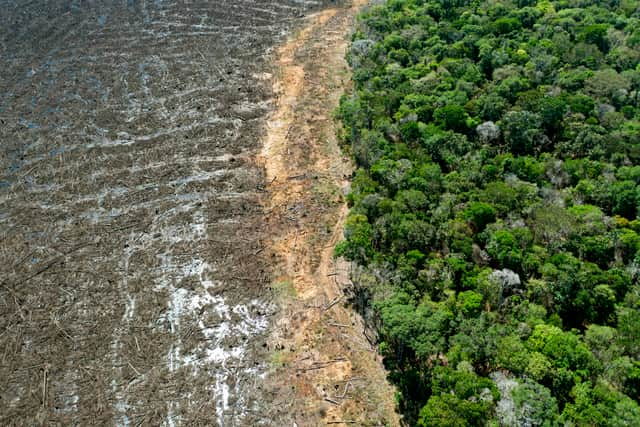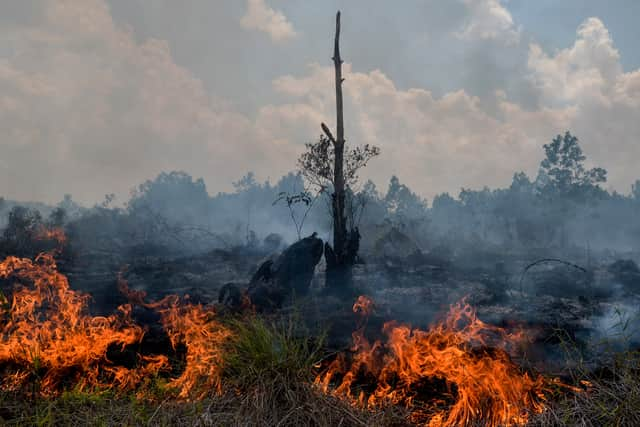What is deforestation? Meaning, effects, how it impacts climate change, and COP26 deal explained
This article contains affiliate links. We may earn a small commission on items purchased through this article, but that does not affect our editorial judgement.
and live on Freeview channel 276
The COP26 climate change summit’s first day saw more than 100 world leaders make a major commitment to both halt and reverse deforestation by 2030.
The announcement involves countries containing 85% of the world’s forests, including Brazil, the Democratic Republic of the Congo and Indonesia.
Advertisement
Hide AdAdvertisement
Hide AdThese countries have been guilty of mass deforestation in a bid to make way for palm oil or soya plantations, cattle ranches and infrastructure, like dams.
£8.75bn of public funding and a further £5.3bn of private investment has been pledged to support the anti-deforestation commitment, according to the UK Government.
But what exactly is deforestation and where is it happening in the world?
Here’s what you need to know.


What is deforestation?
Deforestation is the action of clearing trees from a large area.
Advertisement
Hide AdAdvertisement
Hide AdIt takes place in every country that has forest coverage to fulfil the need for timber, clear land for agriculture and also, to clear a path for major infrastructure projects, like roads and dams.
There have been efforts to make it sustainable by imposing management standards on those who use forest resources.
For example, the Forest Stewardship Council’s certification scheme aims to ensure tree products, such as cardboard and paper, are not damaging to the environment.
But some countries in the developing world carry out uncontrolled, unsustainable deforestation.
Advertisement
Hide AdAdvertisement
Hide AdThis is often allowed to happen because the countries in question do not have strong enough regulation for forests or are happy to turn a blind eye as deforestation can fuel economic growth.


Why is deforestation linked with climate change?
Deforestation is a major driver of climate change.
Trees remove carbon dioxide from the air through photosynthesis and lock the gas inside themselves.
But when they are cut down, this greenhouse gas can return to the atmosphere.
This is especially the case when trees are burnt down - a practice that typically happens when land is being cleared for agricultural use as it is quicker than cutting them down.
Advertisement
Hide AdAdvertisement
Hide AdAnd if they are cut down unsustainably - i.e. chopped down trees aren’t replaced with new ones - it accelerates climate change as there are fewer trees around to ingest CO2.
Deforestation can also have a major impact on rainfall, as forests influence weather patterns.
It is also a major contributor to wildlife loss as over 50% of the world's land-based plants and animals, and around three-quarters of all birds, live in and around forests.
Where is it happening?
The worst areas for unsustainable deforestation are in the tropics, especially in the southern hemisphere (see graphic below).
Advertisement
Hide AdAdvertisement
Hide AdThe World Wildlife Fund for Nature (WWF) estimates 43 million hectares, an area roughly the size of Morocco, was lost in these ‘deforestation fronts’ between 2004 and 2017.
According to the Rainforest Alliance - an NGO which seeks to protect the world’s rainforest - the tropics lost 12 million hectares of tree cover in 2018 alone.
Loading....
Brazil has hit the headlines in recent years for its deforestation activity, which is partly because much of the high-profile Amazon rainforest sits within its borders.
The country’s powerful agriculture and farming lobby has been able to clear swathes of land for cattle farming and soya plantations - a commodity which the UK imports for use in animal feed.
Advertisement
Hide AdAdvertisement
Hide AdIt’s estimated that up to a fifth of the Amazon has been destroyed.
And while the rate of deforestation in the rainforest dropped between the mid-2000s and mid-2010s, it leapt back up by 30% to almost 10,000 square kilometres in 2019 – the largest loss of the South American rainforest in a decade.
Other countries like Indonesia and the Democratic Republic of the Congo - which are home to less well-known rainforests - are also seeing major deforestation to allow for the growth of palm oil plantations.
Palm oil is a key ingredient in products you can find in supermarkets across the globe. For example, it can be found in chocolate and toothpaste.
Advertisement
Hide AdAdvertisement
Hide AdSome manufacturers of these products, like Unilever, have said they are working to eliminate deforestation from their supply chains.
Deforestation has also happened at a large scale in countries like the UK in the past.
According to National Geographic, 80% of Western Europe was forested around 2,000 years ago. Today the figure is 34%.
How many trees are cut down each day?
In 2019, the tropics lost close to 30 football fields' worth of trees every single minute, according to WWF.
Advertisement
Hide AdAdvertisement
Hide AdThis would equate to 43,200 football fields being lost a day.
In the Amazon at least 58,000 hectares of rainforest - an area the size of the Isle of Man - were lost to deforestation in April, Greenpeace statistics show.
This figure was the largest amount of deforestation ever recorded in the rainforest for the month of April.
A message from the editor:
Thank you for reading. NationalWorld is a new national news brand, produced by a team of journalists, editors, video producers and designers who live and work across the UK. Find out more about who’s who in the team, and our editorial values. We want to start a community among our readers, so please follow us on Facebook, Twitter and Instagram, and keep the conversation going. You can also sign up to our email newsletters and get a curated selection of our best reads to your inbox every day.
Comment Guidelines
National World encourages reader discussion on our stories. User feedback, insights and back-and-forth exchanges add a rich layer of context to reporting. Please review our Community Guidelines before commenting.
